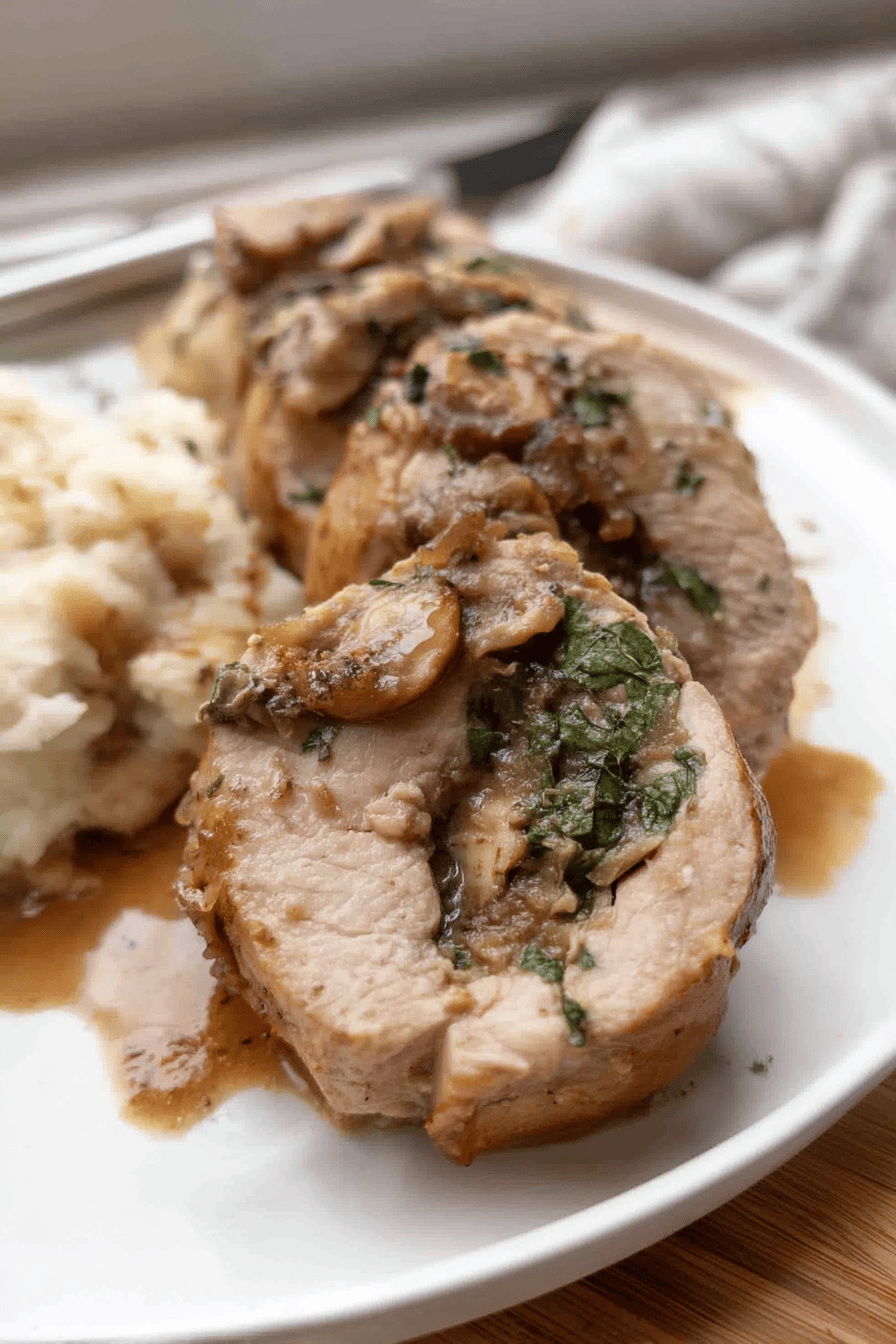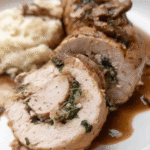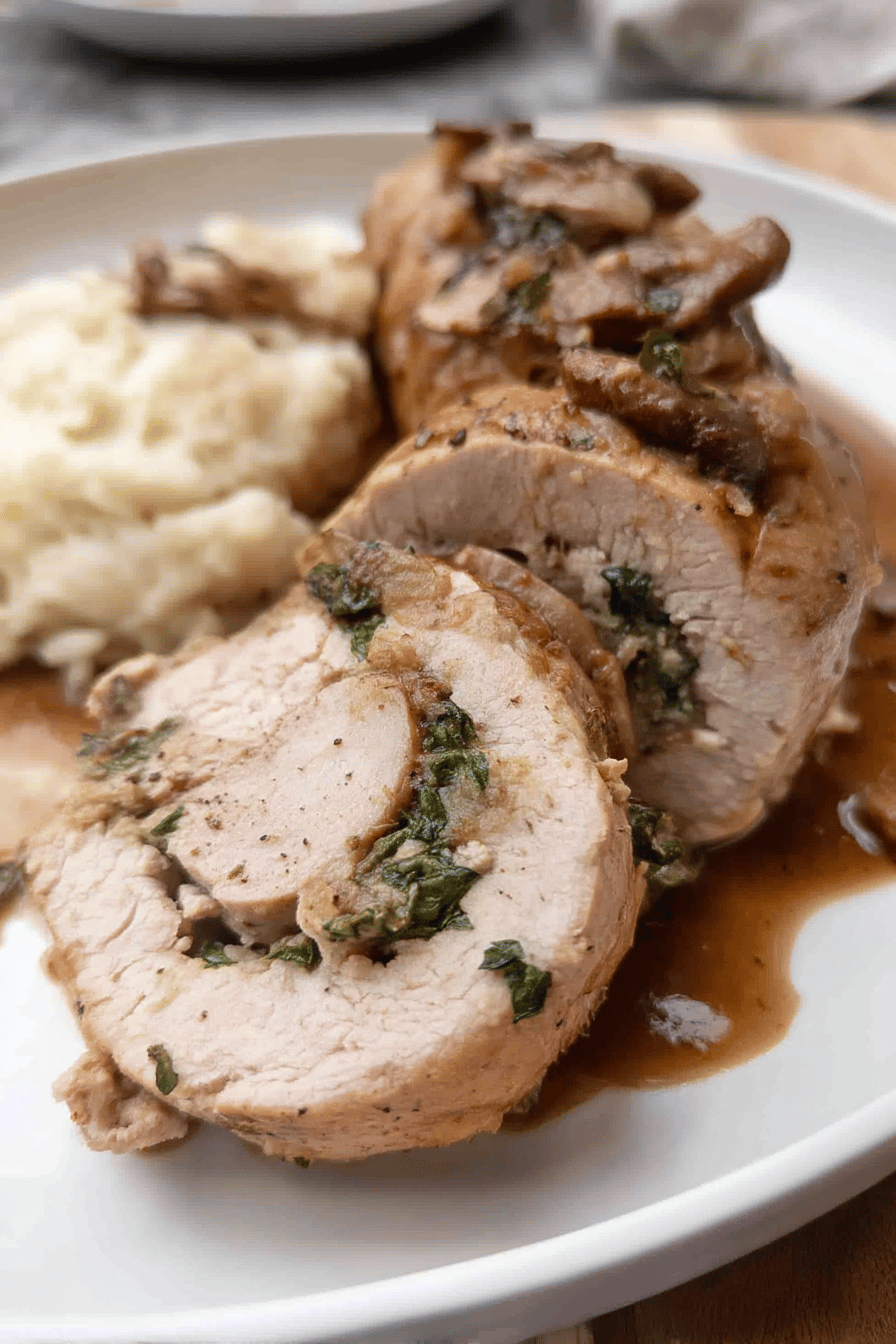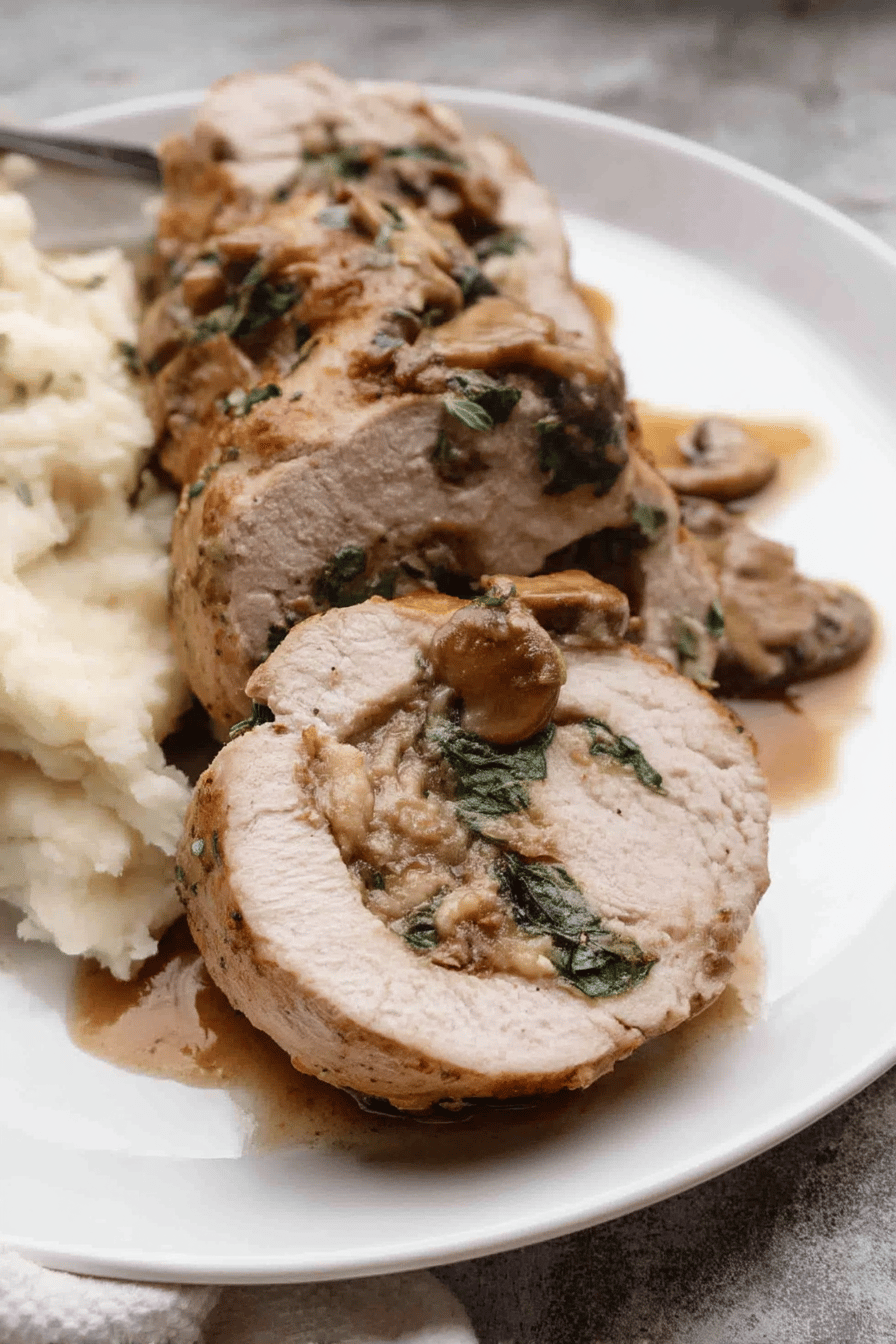Why You’ll Love This Stuffed Pork Tenderloin
- Ease of preparation: This stuffed pork tenderloin recipe is straightforward and quick to prepare, perfect for busy weeknights or casual dinners. With just 15-20 minutes of preparation and about 30 minutes of cooking time, it uses simple techniques like sautéing and roasting that even beginners can master effortlessly.
- Health benefits: Packed with lean pork tenderloin and nutrient-rich fillings including spinach and roasted red pepper, this dish delivers high protein with low carbohydrates and moderate fat content. The inclusion of fresh herbs and vegetables boosts vitamins and antioxidants, supporting overall wellness and balanced nutrition (nutritional benefits of pork).
- Versatility: Adapt this stuffed pork tenderloin to suit different dietary preferences by swapping the filling or seasonings. Whether you need gluten-free, low-calorie, or a warming herb twist, this recipe is flexible enough to accommodate various needs without sacrificing flavor or texture.
- Distinctive flavor: Combining juicy roasted red pepper, savory bacon, earthy mushrooms, and creamy Parmesan in a tender pork roulade creates a unique and satisfying flavor profile. The blend of textures and fresh herbs offers a memorable dish that stands out from classic pork entrees.
Jump To
- 1. Why You’ll Love This Stuffed Pork Tenderloin
- 2. Essential Ingredients for Stuffed Pork Tenderloin
- 3. How to Prepare the Perfect Stuffed Pork Tenderloin: Step-by-Step Guide
- 4. Dietary Substitutions to Customize Your Stuffed Pork Tenderloin
- 5. Mastering Stuffed Pork Tenderloin: Advanced Tips and Variations
- 6. How to Store Stuffed Pork Tenderloin: Best Practices
- 7. FAQs: Frequently Asked Questions About Stuffed Pork Tenderloin
- 8. stuffed pork tenderloin
Essential Ingredients for Stuffed Pork Tenderloin
- 1 1/2 pounds (680 grams) pork tenderloin, silver skin removed – the lean, tender protein base essential for stuffing and roasting
- 2 slices bacon, chopped – adds smoky richness and depth of flavor to the filling
- 6 ounces (170 grams) brown mushrooms, thinly sliced – provides earthy umami and moisture balance
- 1/3 cup (40 grams) chopped onion (about half a small onion) – brings sweetness and aromatic base
- 1 red bell pepper, roasted and diced – contributes smoky sweetness and vibrant color
- 2 cups (60 grams) chopped frozen spinach, thoroughly squeezed dry – adds nutrition and vibrant green color
- 3/4 cup (75 grams) grated Parmesan cheese – lends savory creaminess and binds the filling
- 1/4 cup (10 grams) fresh parsley, chopped – fresh herbal brightness, plus extra for garnish
- 2 tablespoons fresh basil, chiffonade (optional) – offers fragrant, slightly sweet herbal notes
- 1 garlic clove, minced – enhances aroma and depth
- 4 tablespoons olive oil, divided – used for sautéing and searing the tenderloin
- 1 1/2 teaspoons salt, divided – balances flavors in the filling and on the pork
- 1/2 teaspoon black pepper, divided – mild heat to enhance taste
Special Dietary Options
- Vegan: Substitute pork tenderloin with seasoned, large portobello mushrooms or seitan. Replace bacon with smoked tempeh or coconut bacon and Parmesan cheese with nutritional yeast or vegan cheese alternatives.
- Gluten-free: Ensure all seasoning and filling ingredients are naturally gluten-free, and verify any added sauces or spice blends for gluten content.
- Low-calorie: Opt for turkey bacon instead of pork bacon and reduce the amount of olive oil for lighter preparation. Consider skipping cheese or using a reduced-fat version.
For a related flavorful main dish, you may enjoy this garlic parmesan chicken which pairs well for dinner ideas.
How to Prepare the Perfect Stuffed Pork Tenderloin: Step-by-Step Guide
First Step: Prepare the Filling
Start by heating 2 tablespoons of olive oil in a large skillet over medium heat. Add the chopped bacon and cook for 3-4 minutes until browned and crisp. Stir in the thinly sliced brown mushrooms, chopped onion, diced roasted red pepper, and thoroughly squeezed spinach. Sauté the mixture for about 5 minutes until the vegetables are soft and fragrant.
Season the filling with 1/2 teaspoon salt, 1/4 teaspoon black pepper, minced garlic, chopped parsley, and chiffonade basil if using. Stir continuously for another minute to blend the flavors. Remove the skillet from heat and stir in the grated Parmesan cheese. Let the filling cool slightly in a bowl while you prepare the pork tenderloin.
Second Step: Butterfly and Pound the Pork Tenderloin
Remove the silver skin from the pork tenderloin using a sharp knife, carefully sliding underneath it without taking excess meat off, to prevent toughness. Using a boning or slicing knife, butterfly the pork lengthwise without cutting completely through open it like a book to increase the surface area to hold the filling securely.
Place the butterflied tenderloin between two sheets of plastic wrap and gently pound with a meat mallet until it’s evenly about 1/4 to 1/2 inch thick. This helps tenderize the meat and creates an easier rolling surface for the stuffing.
Third Step: Assemble the Stuffed Rolled Tenderloin
Season the inside of the tenderloin lightly with 1/2 teaspoon salt and 1/4 teaspoon black pepper. Spread the cooled vegetable and cheese stuffing evenly over the pork, leaving a 1/2 to 1-inch border around the edges to prevent spillage during rolling.
Firmly roll the pork into a jellyroll shape. Secure the roll using toothpicks placed parallel along the seam or tie it with kitchen twine for extra stability during cooking. Season the exterior of the roulade with the remaining 1 teaspoon salt and 1/4 teaspoon black pepper to enhance flavor in every bite.
Fourth Step: Sear the Pork Tenderloin
Heat the remaining 2 tablespoons olive oil (or substitute grapeseed oil if preferred) in an oven-safe skillet over medium heat. Place the stuffed pork roulade seam-side down and sear for about 2 minutes until golden and crispy. Turn and brown all sides evenly for a total of 6 to 8 minutes. This seals in the juices and creates a beautiful crust.
Fifth Step: Roast the Tenderloin to Finish
Preheat your oven to 350-400°F (175-200°C) depending on your preferred cook time. Transfer the skillet directly into the oven and roast the stuffed pork tenderloin for about 18-20 minutes. Use a meat thermometer to check that the internal temperature reaches 145-150°F (63-66°C), which is ideal for safe consumption while keeping the meat moist with a slight pink center.
Final Step: Rest, Slice, and Serve
Once roasted, remove the skillet from the oven and brush the pork roulade with the pan drippings for extra flavor and shine. Let the meat rest on a cutting board for 10 minutes to allow juices to redistribute and enhance tenderness. Remove toothpicks or twine carefully, then slice the roulade into medallions about 3/4-inch thick. Garnish with additional chopped parsley and serve warm for an impressive presentation and delicious meal.
Resting the stuffed pork tenderloin after roasting is key to juicy, tender slices that bring out the full depth of flavor.
For more pork recipe inspiration with vegetable fillings, check out these stuffed pork recipes and tips.
Dietary Substitutions to Customize Your Stuffed Pork Tenderloin
Protein and Main Component Alternatives
- Replace pork tenderloin with turkey breast or skinless chicken breast for a leaner protein variation that still works well with stuffing.
- For vegetarian or vegan options, consider using large portobello mushrooms, seitan, or tempeh as the main component for stuffing and rolling.
- Bacon can be substituted with turkey bacon or vegan smoked tempeh to reduce fat or remove animal products without losing smoky flavor.
Vegetable, Sauce, and Seasoning Modifications
- Swap spinach with nutrient-rich kale or hearty Swiss chard depending on availability or preference.
- Substitute roasted red bell peppers for sun-dried tomatoes or olives to create different flavor profiles with varying intensity.
- Experiment with seasoning by adding smoked paprika, lemon zest, or fresh herbs like rosemary and thyme for more aromatic and varied taste experiences.
- Use gluten-free soy sauce or tamari if incorporating sauces to maintain gluten-free compliance.
These customization options help make the stuffed pork tenderloin recipe adaptable for a wide range of tastes and dietary choices without sacrificing quality or flavor.
Mastering Stuffed Pork Tenderloin: Advanced Tips and Variations
Pro Cooking Techniques
- Use sous vide cooking to precisely control temperature and ensure the stuffed pork tenderloin remains juicy throughout. Finish with a hot skillet sear for a perfect crust.
- Butterfly the pork tenderloin evenly and pound uniformly for consistent thickness, ensuring even cooking and ease in rolling the filling.
- Secure the roulade firmly with kitchen twine instead of toothpicks for a sturdier hold during longer or moist cooking processes.
Flavor Variations
- Try different cheese types such as goat cheese, mozzarella, or blue cheese in the stuffing for distinctive taste profiles.
- Incorporate herbs like rosemary, thyme, or oregano to highlight the pork’s natural flavors.
- Add a drizzle of balsamic glaze or a light pan sauce made with wine or broth poured over sliced medallions for an elegant finish.
Presentation Tips
- Slice the stuffed pork tenderloin into uniform medallions about 3/4 inch thick for neat plating.
- Garnish with freshly chopped parsley, basil ribbons, or microgreens for color contrast and freshness.
- Arrange slices atop a bed of roasted vegetables or creamy mashed potatoes to complete the plate visually and flavorfully.
Make-Ahead Options
- Prepare and stuff the pork tenderloin ahead of time, securing with twine and refrigerating overnight. Roast just before serving to save time on busy days.
- Leftover stuffed pork tenderloin slices can be used for sandwiches or salads to extend meal versatility.
How to Store Stuffed Pork Tenderloin: Best Practices
| Storage Method | Details | Duration |
|---|---|---|
| Refrigeration | Store leftover stuffed pork tenderloin in an airtight container or wrapped tightly with plastic wrap and foil to retain moisture. | 3-4 days |
| Freezing | Wrap tightly in plastic and aluminum foil or place in a freezer-safe container. Thaw overnight in the refrigerator before reheating. | Up to 6 months |
| Reheating | Warm gently in a preheated oven at 325°F (163°C) until heated through. Avoid microwaving to maintain texture and flavor. | Immediate use after thawing |
| Meal Prep | Slice before storing for easy reheating and portion control. Vacuum sealing can help extend freshness when batch cooking. | Varies based on storage method |

FAQs: Frequently Asked Questions About Stuffed Pork Tenderloin
What is the difference between pork tenderloin and pork loin for stuffing?
Pork tenderloin is smaller, leaner, and more tender than pork loin, which is larger and thicker. Tenderloin cooks faster and is easier to butterfly and stuff evenly, making it a preferred choice for stuffed recipes. In contrast, pork loin often requires longer cooking times and may not hold fillings as well due to its shape.
How do I butterfly a pork tenderloin for stuffing?
To butterfly a pork tenderloin, use a sharp knife to cut horizontally down the side of the tenderloin, stopping just before cutting all the way through. Open it flat like a book, then, if desired, make additional shallow cuts to create flaps for spreading the filling more evenly. This creates a large surface area for stuffing without separating the meat completely.
What steps should I follow to cook stuffed pork tenderloin safely and deliciously?
After stuffing and rolling the tenderloin, secure it tightly with kitchen twine or toothpicks. Sear the rolled pork in a hot skillet until browned on all sides to lock in flavors. Then transfer to the oven and roast until the internal temperature reaches 145°F, which ensures safe cooking while keeping the meat juicy. Allow it to rest for about 10 minutes before slicing to retain moisture.
How should I store and reheat leftover stuffed pork tenderloin?
Store leftovers in an airtight container in the refrigerator for up to 3-4 days or freeze for up to six months. To reheat, thaw frozen portions overnight in the fridge, then warm slices in a covered pan over medium heat until heated through to avoid drying out the meat.
What are some good side dishes to serve with stuffed pork tenderloin?
Roasted vegetables, such as potatoes or carrots, pair well by adding texture and warmth. Fresh green salads provide a light contrast that complements the richness of the stuffed pork. Simple grains like rice or quinoa also work well to round out the meal without overpowering the flavors.

stuffed pork tenderloin
- Total Time: 55-60 minutes
- Yield: Serves 6
- Diet: Gluten-Free
Description
🍖 This stuffed pork tenderloin recipe combines juicy pork with a flavorful shrimp, spinach, and roasted red pepper filling for a satisfying main dish.
🔥 Perfect for special occasions or a cozy dinner, it offers a balance of tenderness and rich tastes that impress your guests.
Ingredients
– 1 1/2 pounds pork tenderloin
– 2 slices bacon for the filling
– 6 ounces brown mushrooms
– 1/3 cup chopped onion
– 1 red bell pepper
– 2 cups chopped frozen spinach
– 3/4 cup grated Parmesan cheese
– 1/4 cup fresh parsley
– 2 tablespoons fresh basil
– 1 garlic clove
– 4 tablespoons olive oil
– 1 1/2 teaspoons salt
– 1/2 teaspoon black pepper
Instructions
First Step: Prepare the FillingStart by heating 2 tablespoons of olive oil in a large skillet over medium heat. Add the chopped bacon and cook for 3-4 minutes until browned and crisp. Stir in the thinly sliced brown mushrooms, chopped onion, diced roasted red pepper, and thoroughly squeezed spinach. Sauté the mixture for about 5 minutes until the vegetables are soft and fragrant.Season the filling with 1/2 teaspoon salt, 1/4 teaspoon black pepper, minced garlic, chopped parsley, and chiffonade basil if using. Stir continuously for another minute to blend the flavors. Remove the skillet from heat and stir in the grated Parmesan cheese. Let the filling cool slightly in a bowl while you prepare the pork tenderloin.
Second Step: Butterfly and Pound the Pork TenderloinRemove the silver skin from the pork tenderloin using a sharp knife, carefully sliding underneath it without taking excess meat off, to prevent toughness. Using a boning or slicing knife, butterfly the pork lengthwise without cutting completely through open it like a book to increase the surface area to hold the filling securely.Place the butterflied tenderloin between two sheets of plastic wrap and gently pound with a meat mallet until it’s evenly about 1/4 to 1/2 inch thick. This helps tenderize the meat and creates an easier rolling surface for the stuffing.
Third Step: Assemble the Stuffed Rolled TenderloinSeason the inside of the tenderloin lightly with 1/2 teaspoon salt and 1/4 teaspoon black pepper. Spread the cooled vegetable and cheese stuffing evenly over the pork, leaving a 1/2 to 1-inch border around the edges to prevent spillage during rolling.Firmly roll the pork into a jellyroll shape. Secure the roll using toothpicks placed parallel along the seam or tie it with kitchen twine for extra stability during cooking. Season the exterior of the roulade with the remaining 1 teaspoon salt and 1/4 teaspoon black pepper to enhance flavor in every bite.
Fourth Step: Sear the Pork TenderloinHeat the remaining 2 tablespoons olive oil (or substitute grapeseed oil if preferred) in an oven-safe skillet over medium heat. Place the stuffed pork roulade seam-side down and sear for about 2 minutes until golden and crispy. Turn and brown all sides evenly for a total of 6 to 8 minutes. This seals in the juices and creates a beautiful crust.
Fifth Step: Roast the Tenderloin to FinishPreheat your oven to 350-400°F (175-200°C) depending on your preferred cook time. Transfer the skillet directly into the oven and roast the stuffed pork tenderloin for about 18-20 minutes. Use a meat thermometer to check that the internal temperature reaches 145-150°F (63-66°C), which is ideal for safe consumption while keeping the meat moist with a slight pink center.
Final Step: Rest, Slice, and ServeOnce roasted, remove the skillet from the oven and brush the pork roulade with the pan drippings for extra flavor and shine. Let the meat rest on a cutting board for 10 minutes to allow juices to redistribute and enhance tenderness. Remove toothpicks or twine carefully, then slice the roulade into medallions about 3/4-inch thick. Garnish with additional chopped parsley and serve warm for an impressive presentation and delicious meal.
Notes
🔪 Always remove the silver skin to ensure tenderness and avoid chewy bites.
🌶️ Roast red peppers before adding to the filling for a smoky, rich flavor.
⏳ Rest the meat after cooking to keep it juicy and tender.
- Prep Time: 15-20 minutes
- Resting Time: 10 minutes
- Cook Time: 30 minutes
- Category: Main Dish, Dinner
- Method: Searing and Roasting
- Cuisine: American
Nutrition
- Serving Size: 1 serving
- Calories: 230 kcal
- Sugar: 1 g
- Sodium: 650 mg
- Fat: 13 g
- Saturated Fat: 2 g
- Unsaturated Fat: 11 g
- Trans Fat: 0 g
- Carbohydrates: 2 g
- Fiber: 1 g
- Protein: 24 g
- Cholesterol: 73 mg
Keywords: stuffed pork tenderloin, shrimp filling, spinach, roasted red pepper



I made this last night for a dinner party, and it was a hit! 🥳 I added some apples to the stuffing for a touch of sweetness, and it turned out great. Thanks for the wonderful recipe!
★★★★★